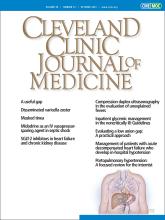
We look initially at laboratory test results with specific intent, checking for major items of concern, alterations in organ function, side effects of medications, or monitoring of drug efficacy. Many results are straightforward, such as measures of blood cell production, kidney or thyroid function, and liver or muscle injury. There are also some derived subtleties included in routine laboratory reports that help put other test results in perspective, such as the red blood cell distribution width when evaluating the cause of anemia.1 Looking at some of these derived “subtleties” can tip off clinicians to the presence of inapparent or subtle systemic pathophysiology, prompting additional focused laboratory investigations. The anion gap (AG) is a derived numeric that appears routinely on electrolyte lab reports, and I suspect is not routinely glanced at unless there is concern for an acid-base disturbance.
I trained in a nephrocentric internal medicine residency program, more specifically in a program that strongly emphasized the evaluation of acid-base and electrolyte status of every patient. I would characterize the AG for us in the 1980s as a “fifth vital sign” in the context of virtually every academic patient presentation. The lasting impact of that training struck a chord decades later, while I was teaching at a small hospital in Japan. In this hospital, they did not routinely order electrolyte panels. Sodium, bicarbonate, creatinine, and others had to be individually requested. The AG was not a vital sign, it was not even on the residents’ minds as a uniformly useful tool. One day when discussing a patient with renal disease, Sjögren syndrome, and joint pain, we pursued the explanation for a low potassium. This led to finding a low bicarbonate and to a discussion on how to distinguish causes of acidosis. This launched us into doing daily discussions of acid-base problems, including the value of the AG.
I, a rheumatologist, remain amused decades later at the educational staying power of my residency training experience that permitted me to facilitate those discussions. There is little question in my mind that every one of my resident peers would still be equally comfortable in those teaching sessions. It is a striking example of how the internal culture and peer-driven expectations of a residency training program can exert a lasting impact on its graduates.
I am not certain of when the concept of the AG became inculcated into clinical practice. Many authors have cited as seminal the lectures of James Gamble,2 although these are now long out of print and hard to find. His “Gamblegrams” illustrated the components of serum electroneutrality and the diagnostic value of monitoring the homeostatic changes that accompany metabolic perturbations. Our conceptual knowledge “bible” as medicine residents included the multiple writings of Emmett and Narins3 and Gabow et al,4 which were supplemented by the real-time teaching of our University of Pennsylvania faculty and the residency class the year ahead of us. It was an implicit expectation that we would pass this knowledge on to the next residency class, with the expectation of its full comprehension and practical implementation at residents’ morning reports and in their clinical notes and daily presentations. Such was the culture of our training.
In routine laboratory assessment, not all cations and anions are measured. But by measuring Na+, Cl−, and bicarbonate, we account for 95% of cations and 85% of anions. The arithmetic difference between the 5% and 15% of those unmeasured charged molecules is the anion gap, and it is generally defined as between 3 and 9 mEq/L (with an estimated fluctuation in a given person of approximately 4). The AG taken in the context of the bicarbonate provides a window to detecting a change in the makeup of charged small molecules and (mainly) proteins. When the AG is significantly elevated, it suggests the presence of an organic acidosis, even when the pH is normal. It can also be mildly elevated in the setting of a primary metabolic alkalosis due to increased lactate generation, and markedly elevated due to ingestion of exogenous anionic compounds.
In this issue of the Journal, Haber et al5 review a less commonly discussed aspect of the AG, the significance of a low value. Apart from its value in teasing out the cause of an acid-base disturbance when elevated, a very low AG suggests a laboratory measurement error, or provides a clue to several possible clinically important protein abnormalities or ingestions that warrant specific investigation.
- Copyright © 2023 The Cleveland Clinic Foundation. All Rights Reserved.






